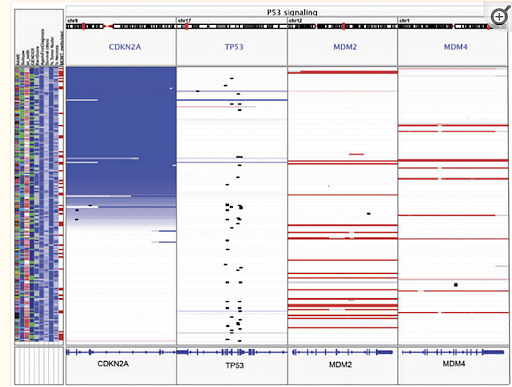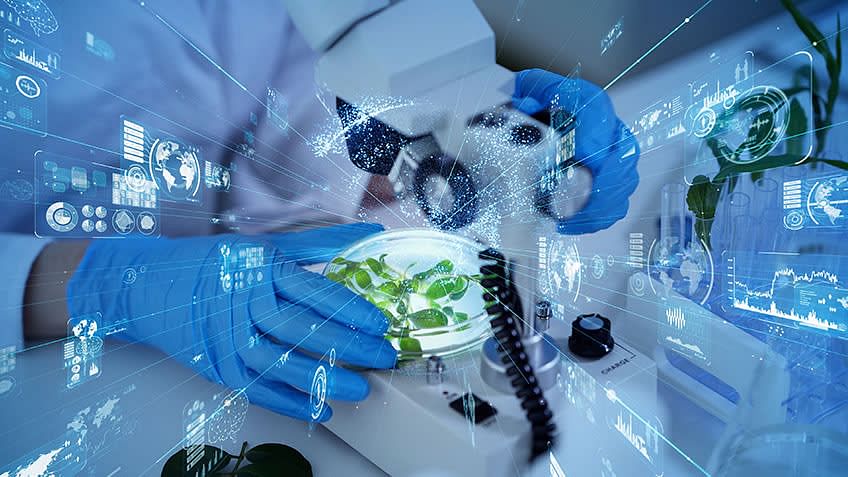Scientists first mapped the human genome in 2003. Since then, the pace of genome sequencing has exploded, resulting in the generation of massive quantities of data. Experts predict that by 2025, genome sequencing will produce 40 exabytes (40 billion gigabytes) of data per year. For comparison, five exabytes is approximately equivalent to all the words ever spoken by humankind.
The challenges of storing, organizing, and gleaning insights from such a large volume of data are immense. That’s why bioinformatics — the application of computational tools to store, analyze, and interpret biological “big data” — is a fast-growing and increasingly important field. Bioinformaticians program and maintain databases of biological data, as well as create and use algorithms to analyze and interpret that data.
Bioinformatics and Data Science in Biology
Bioinformatics is a multidisciplinary field that utilizes computer programming, machine learning, algorithms, statistics, and other computational tools to organize and analyze large volumes of biological data. Fields of biology that generate massive amounts of data include genomics, transcriptomics, proteomics, and metabolomics.
- Genomics is the study of the complete genetic makeup of an organism. It focuses on deoxyribonucleic acid (DNA), the main component of chromosomes and the repository of genetic information. Sequencing just a single human genome generates 200 gigabytes of data. It once took over a decade to sequence a complete human genome. Today, with next generation sequencing (NGS), that same task takes a single day.
- Transcriptomics is the study of transcriptomes, the ribonucleic acid (RNA) transcripts produced by a genome. Scientists are particularly interested in how diseases and environmental factors affect transcript patterns. NGS is used in transcriptomics as well.
- Proteomics is the study of proteins, which carry out cellular work and regulate our bodies’ organs. Protein sequencing is usually done via a process called mass spectrometry.
- Metabolomics is the study of metabolites, small molecules inside of cells, tissues, and fluids in organisms. A better understanding of how metabolites work can help doctors deliver more individualized treatments for patients, a field called precision medicine. Nuclear magnetic resonance and mass spectrometry are used in metabolomics.
Providing the means to map and compare DNA, study protein sequences, and identify patterns in large volumes of data are some of the primary ways bioinformatics aims to improve our understanding of biological processes.
What Is Bioinformatics Used For?
Bioinformatics entails the storage and management of biological data via the creation and maintenance of powerful databases, as well as the retrieval, analysis, and interpretation of data via algorithms and other computational tools. As such, it has applications for a wide range of fields. Here are just a few examples of how bioinformatics helps tackle real-world problems:
- It can help cancer researchers identify which gene mutations cause cancer. Scientists can then develop targeted therapies exploiting that knowledge.
- It can help biologists map evolutionary connections and ancestry.
- It can help pharmaceutical companies develop new drugs customized to a person’s individual genome.
- It can aid in the development of new vaccines.
- It can enable the development of crops that are more resistant to insects and disease.
- It can identify microbes that have the ability to clean-up environmental waste.
- It can improve the health of livestock.
- It can help forensic scientists identify incriminating DNA evidence.
What’s the Difference Between Bioinformatics and Computational Biology? Do Both Require Coding Skills?
Bioinformatics utilizes computer programming and algorithms to store, analyze, and interpret massive volumes of biological data. Computational biology uses computer science, statistics, and mathematics to analyze typically smaller volumes of data. Bioinformatics also incorporates more machine learning and artificial intelligence than does computational biology.
Becoming a bioinformatician requires coding skills and more technical training than becoming a computational biologist. Programming languages commonly used in bioinformatics include Bash, Python, Perl, R, C, and C++. Bioinformatics and computational biology have many overlaps, however, and are often integrated in colleges and research centers.
What Is Bioinformatic Visualization?
Sometimes insights buried deep in a large volume of data can come to light when displayed in the right visual configurations. Bioinformatic visualization employs computerized procedures to transform data into visual representations that make the data more meaningful and easier to interpret. Examples of data visualization include:
- Genome browsers that display genomic data in linear layouts consisting of multiple parallel “tracks,” enabling the comparison of sequencing data and experimental results (see figure.)

- Graphs that can identify outliers, errors, or mistaken assumptions in raw statistical data
- 3D representations of genomes
- 3D representations of proteins
- Visual representations of spatial transcriptomics
Looking forward to becoming a Data Scientist? Check out the Data Science Bootcamp and get certified today.
Conclusion: Bioinformaticians Needed!
We are amassing biological data at speeds and quantities that require increasingly powerful computational tools to store, organize, analyze, and interpret. Life scientists need bioinformatic skills to stay at the forefront of many research fields, while industries ranging from health care to agriculture to environmental conservation stand to benefit from the insights waiting to be gleaned from biological data. If you are passionate about biology, interested in computer programming, and excited about a career in data science, this may be the field for you!
To succeed in this rewarding and in-demand career, check out the Caltech Data Science Bootcamp, offered in collaboration with IBM. Leveraging Simplilearn’s proven applied learning approach, you will learn through a blend of live, instructor-led classes, self-paced videos, hands-on projects in interactive labs, exclusive access to IBM hackathons and Ask Me Anything sessions, and much more. Skills in data science apply to all industries today, so upskilling in this new and critical field is a win-win in any case.
